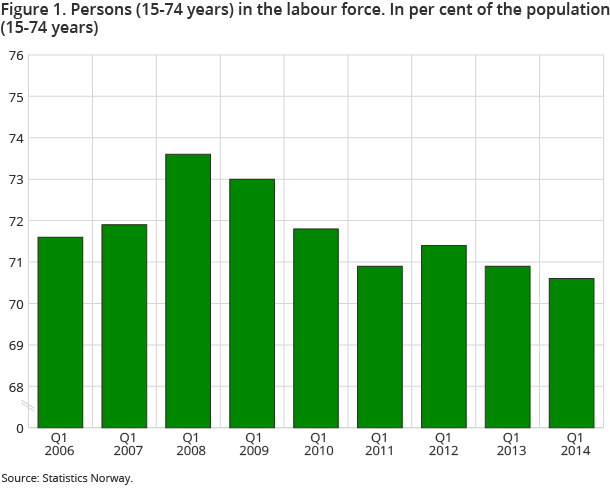Content
Published:
This is an archived release.
Decreased labour force participation among youths
Labour force participation among those aged 15-24 years decreased from 57.7 per cent in the 1st quarter of 2013 to 54.1 per cent in the same quarter of 2014. The decrease was due to fewer young people working part-time in combination with studying.
| 1st quarter 2014 | 1st quarter 2013 - 1st quarter 2014 | |||
|---|---|---|---|---|
| Absolute numbers | Per cent | Change in absolute numbers | Change in percentage points | |
| Labour force | ||||
| Both sexes | 2 704 000 | 70.6 | 24 000 | -0.3 |
| Males | 1 431 000 | 73.2 | 13 000 | -0.4 |
| Females | 1 273 000 | 67.8 | 11 000 | -0.3 |
| Employed persons | ||||
| Both sexes | 2 606 000 | 68.0 | 23 000 | -0.3 |
| Males | 1 376 000 | 70.4 | 14 000 | -0.3 |
| Females | 1 230 000 | 65.5 | 10 000 | -0.3 |
| Unemployed | ||||
| Both sexes | 97 000 | 3.6 | -1 000 | 0.0 |
| Males | 55 000 | 3.8 | -1 000 | -0.1 |
| Females | 42 000 | 3.3 | 0 | 0.0 |

The Labour Force Survey (LFS) shows that the labour force participation rate among the population aged 15-74 years was 70.6 per cent in the 1st quarter of 2014. This was a decrease of 0.3 percentage points from the 1st quarter of the previous year. The decrease was among the under-25s, due to fewer young men and women combining part-time work with studying. However, labour force participation increased among those aged 25-74 years from the 1st quarter of 2013 to the same quarter of 2014. The increase was strongest among those aged 55 years or older, especially with regard to women.
The strong growth in labour force participation among women aged 55 years or older is in line with a long-term trend. In the year 2000, the labour force participation rate for men was 9.1 percentage points higher than for women. The difference fell to 5.5 percentage points in 2013.
23 000 more employed persons last year
The number of employed persons increased by 23 000 from the 1st quarter of 2013 to the same quarter of 2014. The increase was among the over-24s and was only in the form of more full-time work. This applied to both sexes, but part-time work is still much more common among women. Among the employed persons in the 1st quarter of 2014, 39 per cent of the women worked part-time – compared to 14 per cent of the men.
Among persons employed part-time in the 1st quarter of 2014, 11 per cent were underemployed. This was down 1 percentage point from the same quarter the previous year. The underemployed are part-time employees who have tried to find more work. The time the 71 000 underemployed persons wanted to work extra in the 1st quarter of 2014 corresponded to 25 000 full-time jobs.
Stable unemployment
Unemployment was approximately the same level in the 1st quarter of 2014 as in the 1st quarter of 2013. The long-term unemployment corresponded to 29 per cent of the unemployment in the 1st quarter of 2014, compared to 24 per cent in the 1st quarter of 2013. The long-term unemployed are persons who have been unemployed for more than 26 weeks. The average period of time an unemployed person is unemployed was 26 weeks in the 1st quarter of 2014; four weeks longer than in the same quarter the previous year.
Contact
-
Arbeidsmarked og lønn
E-mail: arbeidsmarked@ssb.no
-
Erik Herstad Horgen
E-mail: erik.horgen@ssb.no
tel.: (+47) 93 08 68 62
-
Håvard Hungnes Lien
E-mail: havard.lien@ssb.no
tel.: (+47) 40 90 26 06
